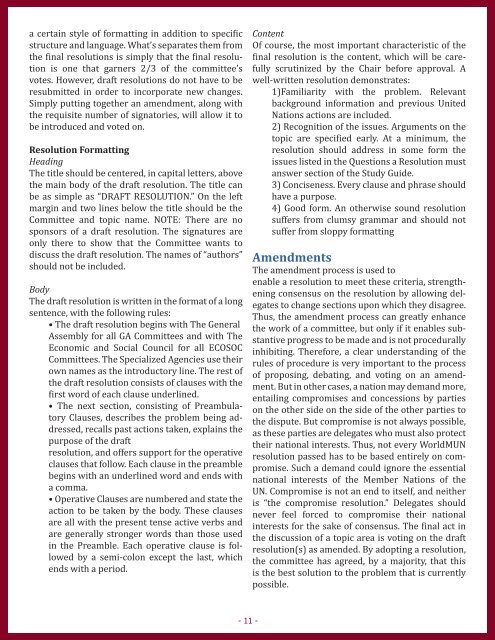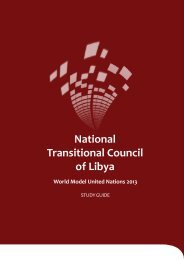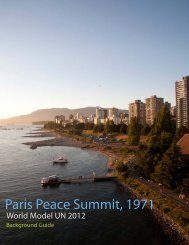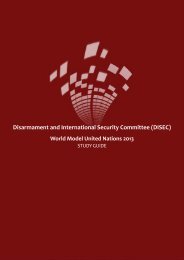here - World Model United Nations
here - World Model United Nations
here - World Model United Nations
You also want an ePaper? Increase the reach of your titles
YUMPU automatically turns print PDFs into web optimized ePapers that Google loves.
a certain style of formatting in addition to specific<br />
structure and language. What’s separates them from<br />
the final resolutions is simply that the final resolution<br />
is one that garners 2/3 of the committee’s<br />
votes. However, draft resolutions do not have to be<br />
resubmitted in order to incorporate new changes.<br />
Simply putting together an amendment, along with<br />
the requisite number of signatories, will allow it to<br />
be introduced and voted on.<br />
Resolution Formatting<br />
Heading<br />
The title should be centered, in capital letters, above<br />
the main body of the draft resolution. The title can<br />
be as simple as “DRAFT RESOLUTION.” On the left<br />
margin and two lines below the title should be the<br />
Committee and topic name. NOTE: T<strong>here</strong> are no<br />
sponsors of a draft resolution. The signatures are<br />
only t<strong>here</strong> to show that the Committee wants to<br />
discuss the draft resolution. The names of “authors”<br />
should not be included.<br />
Body<br />
The draft resolution is written in the format of a long<br />
sentence, with the following rules:<br />
• The draft resolution begins with The General<br />
Assembly for all GA Committees and with The<br />
Economic and Social Council for all ECOSOC<br />
Committees. The Specialized Agencies use their<br />
own names as the introductory line. The rest of<br />
the draft resolution consists of clauses with the<br />
first word of each clause underlined.<br />
• The next section, consisting of Preambulatory<br />
Clauses, describes the problem being addressed,<br />
recalls past actions taken, explains the<br />
purpose of the draft<br />
resolution, and offers support for the operative<br />
clauses that follow. Each clause in the preamble<br />
begins with an underlined word and ends with<br />
a comma.<br />
• Operative Clauses are numbered and state the<br />
action to be taken by the body. These clauses<br />
are all with the present tense active verbs and<br />
are generally stronger words than those used<br />
in the Preamble. Each operative clause is followed<br />
by a semi-colon except the last, which<br />
ends with a period.<br />
- 11 -<br />
Content<br />
Of course, the most important characteristic of the<br />
final resolution is the content, which will be carefully<br />
scrutinized by the Chair before approval. A<br />
well-written resolution demonstrates:<br />
1)Familiarity with the problem. Relevant<br />
background information and previous <strong>United</strong><br />
<strong>Nations</strong> actions are included.<br />
2) Recognition of the issues. Arguments on the<br />
topic are specified early. At a minimum, the<br />
resolution should address in some form the<br />
issues listed in the Questions a Resolution must<br />
answer section of the Study Guide.<br />
3) Conciseness. Every clause and phrase should<br />
have a purpose.<br />
4) Good form. An otherwise sound resolution<br />
suffers from clumsy grammar and should not<br />
suffer from sloppy formatting<br />
Amendments<br />
The amendment process is used to<br />
enable a resolution to meet these criteria, strengthening<br />
consensus on the resolution by allowing delegates<br />
to change sections upon which they disagree.<br />
Thus, the amendment process can greatly enhance<br />
the work of a committee, but only if it enables substantive<br />
progress to be made and is not procedurally<br />
inhibiting. T<strong>here</strong>fore, a clear understanding of the<br />
rules of procedure is very important to the process<br />
of proposing, debating, and voting on an amendment.<br />
But in other cases, a nation may demand more,<br />
entailing compromises and concessions by parties<br />
on the other side on the side of the other parties to<br />
the dispute. But compromise is not always possible,<br />
as these parties are delegates who must also protect<br />
their national interests. Thus, not every <strong>World</strong>MUN<br />
resolution passed has to be based entirely on compromise.<br />
Such a demand could ignore the essential<br />
national interests of the Member <strong>Nations</strong> of the<br />
UN. Compromise is not an end to itself, and neither<br />
is “the compromise resolution.” Delegates should<br />
never feel forced to compromise their national<br />
interests for the sake of consensus. The final act in<br />
the discussion of a topic area is voting on the draft<br />
resolution(s) as amended. By adopting a resolution,<br />
the committee has agreed, by a majority, that this<br />
is the best solution to the problem that is currently<br />
possible.
















